Refer to CBSE Class 11 Physics Laws of Motion MCQs Set D provided below available for download in Pdf. The MCQ Questions for Class 11 Physics with answers are aligned as per the latest syllabus and exam pattern suggested by CBSE, NCERT and KVS. Chapter 4 Laws of Motion Class 11 MCQ are an important part of exams for Class 11 Physics and if practiced properly can help you to improve your understanding and get higher marks. Refer to more Chapter-wise MCQs for CBSE Class 11 Physics and also download more latest study material for all subjects
MCQ for Class 11 Physics Chapter 4 Laws of Motion
Class 11 Physics students should refer to the following multiple-choice questions with answers for Chapter 4 Laws of Motion in Class 11.
Chapter 4 Laws of Motion MCQ Questions Class 11 Physics with Answers
Question: An object is gently placed on a long converges belt moving with l l ms-1 .If the coefficient of friction is 0.4, then the block will slide in the belt upto a distance of
a) 10.21 m
b) 15.125 m
c) 20.3m
d) 25.6 m
Answer: b
Question: The backside of a truck is open and a box of 40 kg is placed 5 m away from the rear end. The coefficient of friction of the box with the surface of the truck is 0.15. The truck starts from rest with 2 m/s2 acceleration. Calculate the distance covered by the truck when the box falls off.
a) 20m
b) 30m
c) 40m
d) 50m
Answer: a
Question: A block of mass 0.18 kg is attached to a spring of force constant 2 NI m . The coefficient of friction between the block and the floor is 0.1. Initially the block is at rest and the spring is unstretched. An impulse is given to the block. The block slides a distance of0.06 m and comes to rest for the first time the initial velocity of the block in mis is v= N I 10. Then, N is
a) 2
b) 3
c) 4
d) 6
Answer: c
Question: Two masses 8 kg and 12 kg are connected at the two ends of a string that goes over a frictionless pulley. Calculate the acceleration of the masses and the tension in the string. (take, g = 10m/s2)
a) 8m/s2 ,144N
b) 4m/s2 ,112N
c) 6m/s2 , 128N
d) 2m/s2 ,96N
Answer: d
Question: A steel wire can withstand a load upto 2940 N. A load of 150 kg is suspended from a rigid support. The maximum angle through which the wire can be displaced from the mean position, so that the wire does not break when the load passes through the position of equilibrium, is
a) 30°
b) 60°
c) 80°
d) 85
Answer: b
Question: A 0.5 kg ball moving with a speed of 12 m/s strikes a hard wall at an angle of 30° with the wall. It is reflected with the same speed at the same angle. If the ball is in contact with the wall for 0.25 seconds, the average force acting on the wall is
a) 96 N
b) 48 N
c) 24 N
d) 12 N
Answer: c
Question: When milk is churned, cream gets separated due to
a) centripetal force
b) centrifugal force
c) fricitional force
d) gravitational force
Answer: b
Question: A monkey is decending from the branch of a tree with constant acceleration. If the breaking strength of branch is 75% of the weight of the monkey, the minimum acceleration with which monkey can slide down without breaking the branch is
b) 3g/4
c) g/4
d) g/2
Answer: c
Question: Block A of mass m and block B of mass 2m are placed on a fixed triangular wedge by means of a massless, inextensible string and a frictionless pulley as shown in figure. The wedge is inclined at 45° to the horizontal on both the sides. The coefficient of friction between the block A and the wedge is 2/3 and that between the block B and the wedge is 1/3 and both the blocks A and B are released from rest, the acceleration of A will be

a) -1
b) 1.2
c) 0.2
d) zero
Answer: d
Question: In the figure shown, m1 = IO kg, m2 = 6 kg, m3 = 4 kg. If T3 = 40N, T2 = ?

a) 13 N
b) 32 N
c) 25 N
d) 35 N
Answer: b
Question: The coefficient of limiting friction μ is defined as

Answer: c
Question: Two masses M and M/2 are joined together by means of light inextensible string passed over a frictionless pulley as shown in the figure. When the bigger mass is released, the small one will ascend with an acceleration of
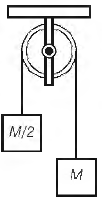
a) I
b) 3g/32
c) I
d) g
Answer: a
Question: The pulleys and strings shown in the figure are smooth and of negligible mass. For the system to remain in equilibrium, the angle 0 should be
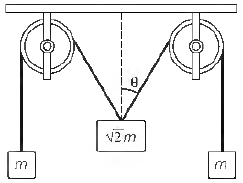
a) 0°
c) 45°
b) 30°
d) 60°
Answer: c
Question: A block B is pushed momentarily along a horizontal surface with an initial velocity v. If μ is the coefficient of sliding friction between B and the surface, block B will come to rest after a time

a) v/gμ
b) gμ/V
c) g/V
d) V/g
Answer: a
Question: If a street light of mass M is suspended from the end of a uniform rod of length L in different possible patterns as shown in figure, then
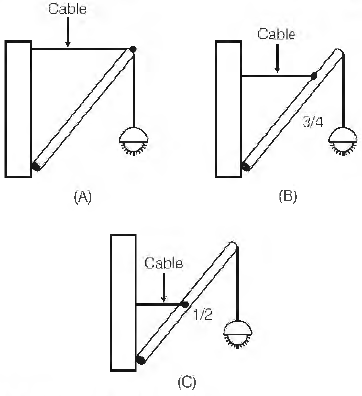
a) pattern A is more sturdy
b) pattern B is more sturdy
c) pattern C is more sturdy
d) All will have same sturdiness
Answer: a
Question: The adjacent figure is the part of a horizontally stretched net. Section AB is stretched with a force of 10 N. The tensions in the sections BC and BF are
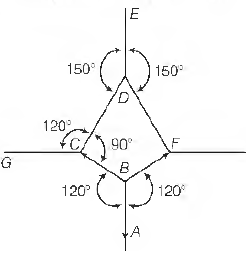
a) 10N, 11 N
b) 10N, 6N
c) ION, JON
d) Can't be calculated due to insufficient data
Answer: c
Question: A mass M kg is suspended by a weightless string. The horizontal force required to hold the mass at 60° with the vertical is

Answer: b
Question: Block A of mass 2 kg is placed over block B of mass 8 kg. The combination is placed over a rough horizontal surface. Coefficient of friction between B and the floor is 0.5. Coefficient of friction between A and Bis 0.4. A horizontal force of 10 N is applied on block B. The force of friction between A and B is

a) zero
c) 40N
b) SON
d) IOON
Answer: b
Question: In the arrangement shown in figure, the strings are light and inextensible. The surface over which blocks are placed is smooth. What is the acceleration of each block?

a) 8 ms-2
b) 4 ms-2
c) 2 ms-2
d) 14 rns-2
Answer: b
Question: A block A weighing 100 kg rests on a block B and is tied with a horizontal string to the wall at C. Block B weighs 200 kg. The coefficient of friction between A and Bis 0.25 and between B and the surface is l /3. The horizontal force P necessary to move the block B should be (take, g = 10m/s2)
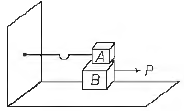
a) l150N
b) 1250N
c) 1300N
d) 1420N
Answer: b
Question: A block of mass M placed on a frictionless horizontal table is pulled by an other block of mass m hanging vertically by a massless string passing over a frictionless pulley. The tension in the string is

Answer: d
Question: The tension in the string in the pulley system shown in the figure is
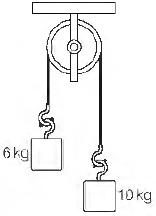
a) 75 N
b) 80 N
c) 7.5 N
d) 30 N
Answer: a
Question: Two blocks of masses 1 kg and 2 kg are com1ected by a metal wire going over a smooth pulley as shown in figure. The breaking stress of the metal is 2 x 109 Nm - z. What should be the minimum radius of the wire used if it is not to break? (take, g = lOms-2)

a) 4.6x l0-5 m
c) 2.5 X 10-6 m
b) 4.6 x 10-6 m
d) 2.5 X 10-5 m
Answer: a
Question: Three blocks of masses m1, m2 and m3 are connected by massless string as shown kept on a frictionless table.

They are pulled with a force T3 = 40 N. If m1 = IO kg, m2 = 6 kg and m3 = 4 kg, the tension T2 will be
a) 20 N
c) 40 N
c)l ON
d) 32 N
Answer: d
Question: In the given figure, the pulley is assumed massless and frictionless. If the friction force on the object of mass m is f, then its acceleration in terms of the force F will be equal to
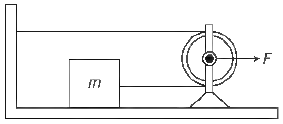

Answer: d
Question: Two masses m1 and m2 (m1 > m2 ) are connected by massless flexible and inextensible string passed over massless and frictionless pulley. The acceleration of centre of mass is
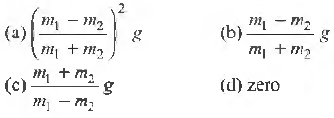
Answer: a
Question: A body of weight 2 kg is suspended as shown in figure. The tension T1 in the horizontal string (in kg-wt) is
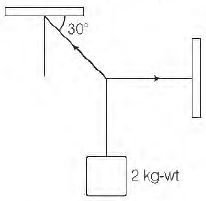
a) 2✓3
b) ✓3/2
c) ✓3
d) 2
Answer: a
Question: An object is kept on a smooth inclined plane of 1 in /. The horizontal acceleration to be imparted to the inclined plane so that the object is stationary relative to the inclined is

Answer: c
Question: Two blocks of masses M and m are connected by a string passing over a pulley as shown in the figure. The downward acceleration of the block with mass m i

a) Ml (m + M)g
c) (m+ M)I mgM
b) mgl(m + M)
d) (n + M)I Mg
Answer: b
Question: Two masses A and B of 15 kg and 10 kg are connected with a string passing over a frictionless pulley fixed at the corner of a table (as shown in figure). The coefficient of friction between the table and block is 0.4. The minimum mass of C, that may be placed on A to prevent it from moving is
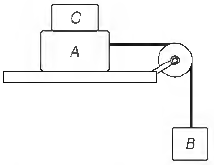
a) 10 kg
b) 5 kg
c) zero
d) 15 kg
Answer: a
Question: Three blocks of masses 4 kg, 2 kg and 1 kg respectively are in contact on a frictionless table as shown in the figure. If a force of 14 N is applied on the 4 kg block, the contact force between the 4 kg and the 2 kg block will be

a) 2 N
b) 6 N
c) 8 N
d) 14 N
Answer: b
| CBSE Class 11 Physics Motion in a Plane MCQs Set A |
| CBSE Class 11 Physics Motion in a Plane MCQs Set B |
| CBSE Class 11 Physics Motion in a Plane MCQs Set C |
| CBSE Class 11 Physics Work Energy and Power MCQs Set A |
| CBSE Class 11 Physics Work Energy and Power MCQs Set B |
| CBSE Class 11 Physics Work Energy and Power MCQs Set C |
| CBSE Class 11 Physics Systems of Particles and Rotational Motion MCQs Set A |
| CBSE Class 11 Physics Systems of Particles and Rotational Motion MCQs Set B |
| CBSE Class 11 Physics Gravitation MCQs Set A |
| CBSE Class 11 Physics Gravitation MCQs Set B |
| CBSE Class 11 Physics Gravitation MCQs Set C |
| CBSE Class 11 Physics Thermodynamic MCQs Set A |
| CBSE Class 11 Physics Thermodynamic MCQs Set B |
| CBSE Class 11 Physics Thermodynamic MCQs Set C |
| CBSE Class 11 Physics Kinetic Theory MCQs Set A |
| CBSE Class 11 Physics Kinetic Theory MCQs Set B |
| CBSE Class 11 Physics Oscillations MCQs Set A |
| CBSE Class 11 Physics Oscillations MCQs Set B |
| CBSE Class 11 Physics Oscillations MCQs Set C |
| CBSE Class 11 Physics Waves MCQs Set A |
| CBSE Class 11 Physics Waves MCQs Set B |
| CBSE Class 11 Physics Waves MCQs Set C |
| CBSE Class 11 Physics Waves MCQs Set D |
| CBSE Class 11 Physics MCQs Set 1 |
| CBSE Class 11 Physics MCQs Set 2 |
| CBSE Class 11 Physics MCQs Set 3 |
| CBSE Class 11 Physics MCQs Set 4 |
| CBSE Class 11 Physics MCQs Set 5 |
| CBSE Class 11 Physics Physical World MCQs Set A |
| CBSE Class 11 Physics Physical World MCQs Set B |
MCQs for Chapter 4 Laws of Motion Physics Class 11
Expert teachers of studiestoday have referred to NCERT book for Class 11 Physics to develop the Physics Class 11 MCQs. If you download MCQs with answers for the above chapter you will get higher and better marks in Class 11 test and exams in the current year as you will be able to have stronger understanding of all concepts. Daily Multiple Choice Questions practice of Physics will help students to have stronger understanding of all concepts and also make them expert on all critical topics. After solving the questions given in the MCQs which have been developed as per latest books also refer to the NCERT solutions for Class 11 Physics. We have also provided lot of MCQ questions for Class 11 Physics so that you can solve questions relating to all topics given in each chapter. After solving these you should also refer to Class 11 Physics MCQ Test for the same chapter.
You can download the CBSE MCQs for Class 11 Physics Chapter 4 Laws of Motion for latest session from StudiesToday.com
Yes, the MCQs issued by CBSE for Class 11 Physics Chapter 4 Laws of Motion have been made available here for latest academic session
You can find CBSE Class 11 Physics Chapter 4 Laws of Motion MCQs on educational websites like studiestoday.com, online tutoring platforms, and in sample question papers provided on this website.
To prepare for Chapter 4 Laws of Motion MCQs, refer to the concepts links provided by our teachers and download sample papers for free.
Yes, there are many online resources that we have provided on studiestoday.com available such as practice worksheets, question papers, and online tests for learning MCQs for Class 11 Physics Chapter 4 Laws of Motion

